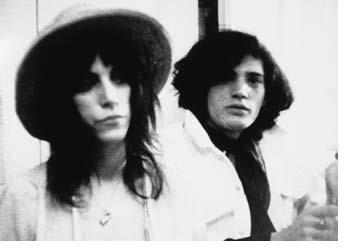Just Kids, a Memoir by Patti Smith: “Because of Robert”
Partially a proclamation to the 1970’s, the artists and the derelicts, the rich and poor, the talented and talent-less, “Just Kids” stands as an ode to friendship and love; everything in between. Patti Smith’s memoir is poetic and true with an honesty and straightforwardness that is disguised in her poetry and music. Smith is a sage, a modern day Siddhartha reliving and recounting her experiences with the wisdom only experience and reflection can procure. Opening the first pages of the stoic purple hardcover book one notices the choice of font, the simplicity of the layout and timelessness of the physicality of a book. The story told is the same: stoic, knowing, and open for a reader to take what he or she needs. The reader finds in the pages a retelling of Patti’s youth, her innocence, drive, ambition and devotion. Although the book is splashed with images of lanky Patti in her 20’s, her voice has slithers of grey and insight. It is as if she had been courting the tale her entire life, rolling it over and over, negotiating, chastising, disbelieving, and when the first words spiraled off her Remington typewriter she finally understood how and why those years of glamorous poverty and community of strangers gave way for the artist within.
We are introduced to young Patti in her home in Chicago and the foundation from which her artistic inclination, intellectual curiosity, and austere simplicity, are rooted. Her father admired the works of Salvador Dali while her mother taught her to kneel down by her bed and pray. Little did Patti, the rebellious punk rocker, know the significance these notions would carry. Years later in the Chelsea Hotel, in the blur of the faceless famous, Dali acknowledged her presence: “You are like a gothic crow.” From Chicago she and her family move to New Jersey; she becomes alienated from the life she was familiar with but this move initiated her bond with literature. Her character deepens, as do her relationships with her siblings; relationships that will keep her grounded and free.
Patti’s steadfast devotion is part of her nature. She never veers too far from poetry, music, or the people whom she loves. Her commitment, inspiration and fortitude are unyielding. Just Kids tells the life and love past of Robert Mapplethorpe. He was a multi faceted artist who showed Patti the life of a true artist. He remains the artist of her life as he continues to be her muse. The memoir fulfills a promise to Mapplethorpe: “Before Robert died, I promised him that I would one day write our story.” The love they shared was unique in that they were kindred spirits, devoted and married to each other by forces beyond explanation. There is a mystical aura to their friendship filled with coincidences and knowing; a kind of trust that comes from beyond the world of matter driven by fate. With their separate artistic visions they complimented each other, challenged each other and depended on each other. They found balance in chaos, a routine of Nescafe, “bad” doughnut shops, and a muse in one another. As a couple they waxed and waned but their foundation for an everlasting friendship had been sealed.
Historical moments – markers in time –ground the story. We hear the artists’ reply to the Son of Sam horrors, the Kent State Massacre, the assassination of Robert F. Kennedy and Martin Luther King. Smith observes the change in the air, the attitude shift from the peace peddling hippies to the transcendentalist beatnik poets to the defiant, questioning artists who will become the forbearers of Punk and the underground downtown art movement of the early 70’s. The disorder of the changing face of America stood as comrade, instigator, and bystander to Patti and Robert’s own relationship. The reader witnesses their many phases, their hunger and need for each other and mutual understanding of an unyielding bond.
Just Kids is a salute to an uncompromising artistic ethic she and Mapplethorpe pursued. It is a celebration of youth and the peculiar satisfaction of freedom regardless of how many burnt cups of coffee, day old rolls, or second-hand stores one must endure. For it was not a matter of subjectification, it was a matter of being free in New York City, free to board in the Chelsea Hotel, free to sleep in Tompkins Square Park, free to express the vision of the artists’ truth. Patti Smith’s mythic storytelling might come as a revelation, her references to God and the power of prayer, her religious upbringing, and the faith that embossed her life gave her certain buoyancy –trust in herself and trust in progress: the journey of her life. Her rowdy stage performances of the 70’s and critique of socio-political happenings hardly fit with the geeky bookstore clerk of her youth. Smith shares her excitement in feeling the changed energy in the air when Bob Dylan attended his first Patti Smith performance. She calls it an “initiation,” as if she needed that nod from another poet whom she respected to confirm, validate, and encourage her own artistic quest.
Smith offers an intimate account of a bourgeoning art scene in downtown New York. She is straightforward, honest, and romantic. Her commitment to art is both a dedication and allegiance to the many that inspired her: Rimbaud, Genet, Dubuffet, Piaf; and the many that challenged, protected and collaborated with her: Dylan, Ginsberg, Shepherd, Hamill. But among them all it was Robert Mapplethorpe that taught her to see and practice through the lens of an artist.
